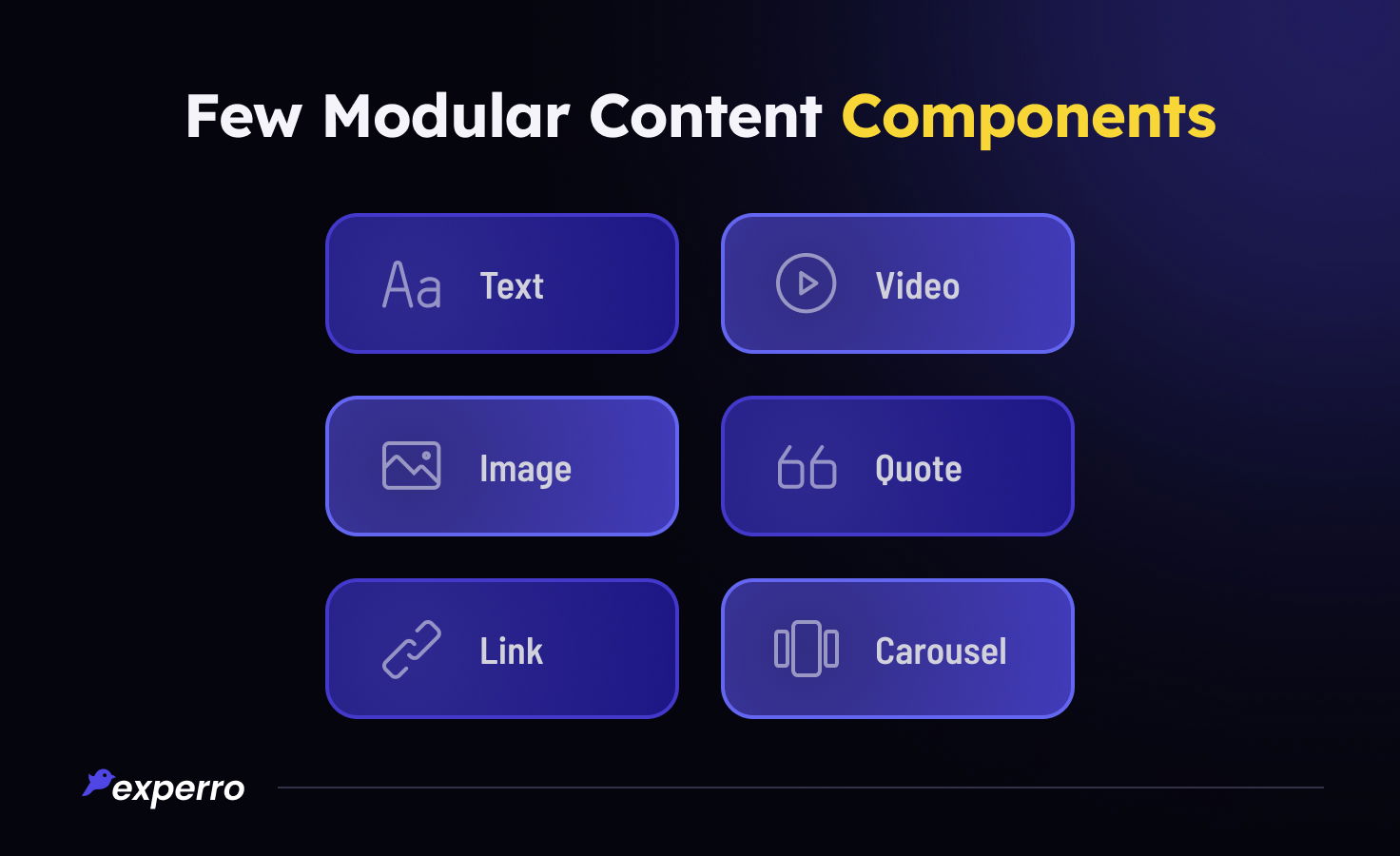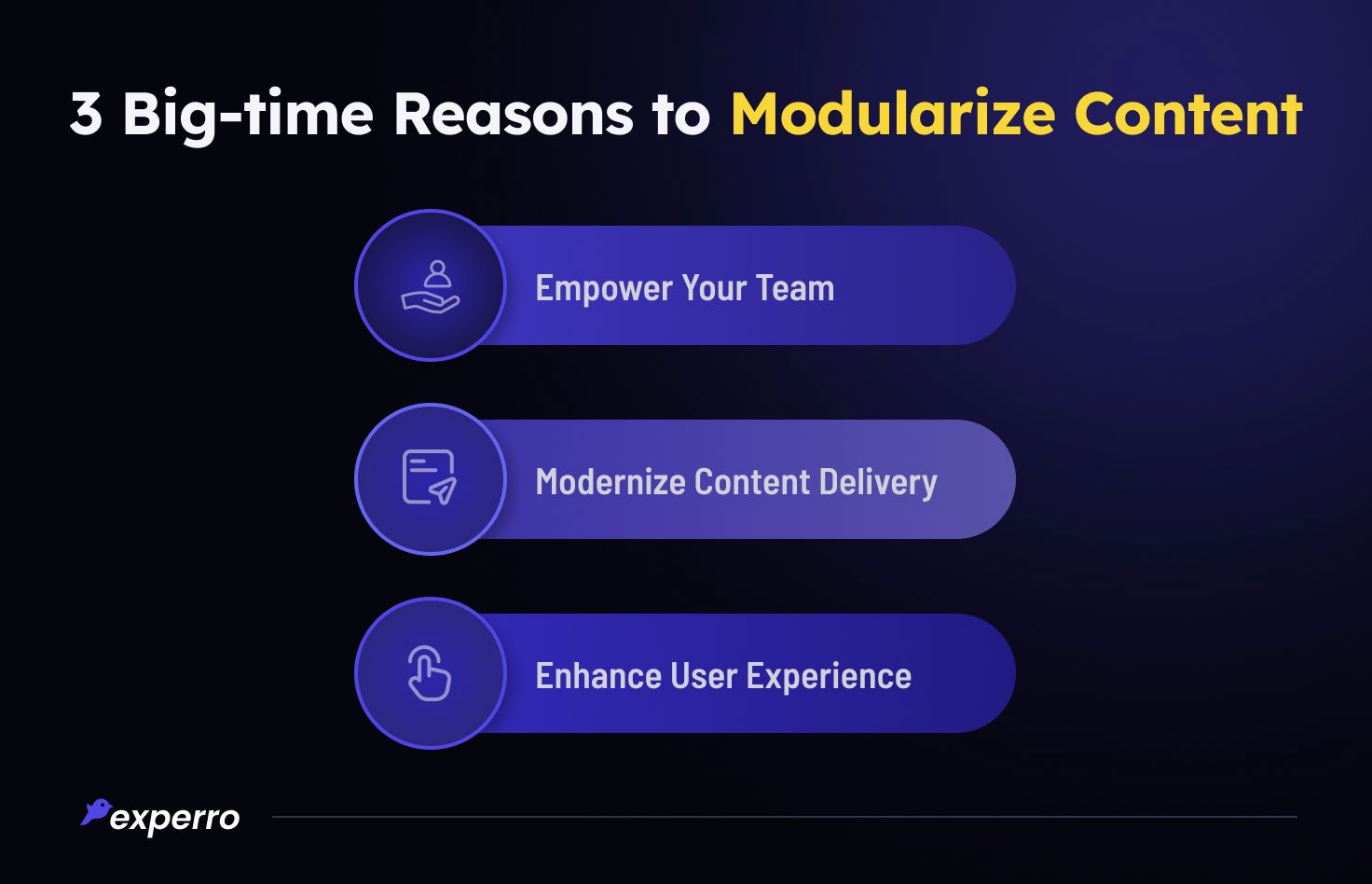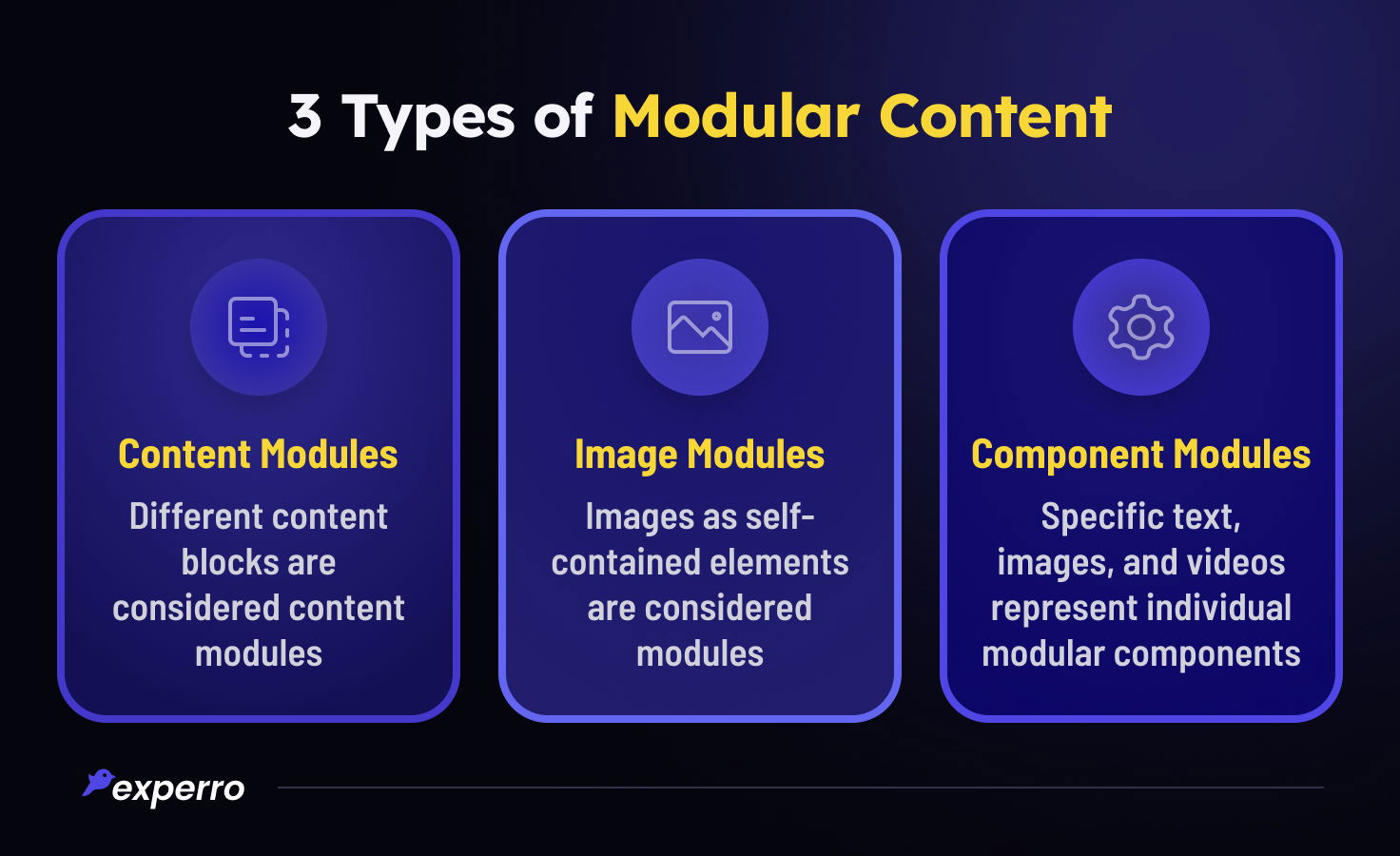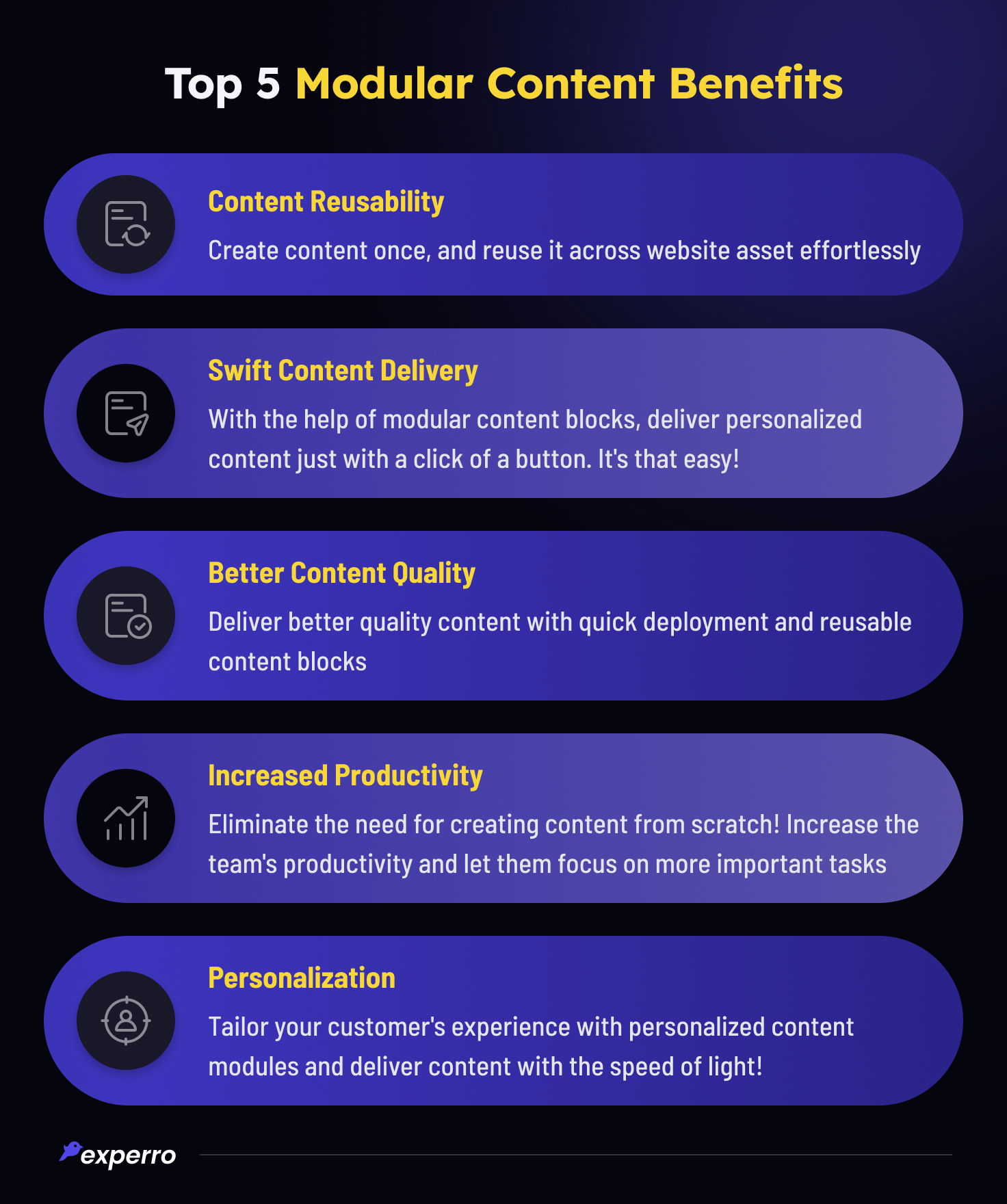- Blog
- Headless CMS
- 11 min read
Headless CMS Modular Content Approach For 15x More Efficiency
Published
25 June 2024Updated
2 September 2025

Key Takeaways
- Adopting the headless CMS's modular content approach opens possibilities for organizations seeking to optimize effective content delivery.
- By breaking down content into smaller reusable units, it eliminates repeated content creation.
- Moreover, content modularization saves time and increases the productivity of employees.
Did you know? 55% of the marketers believe creating more content and posting more frequently leads to increased brand engagement. Consistently creating engaging content is the key to capturing and retaining users' attention.
However, the daunting task of quickly generating fresh content for every webpage on your website becomes overwhelming. This is where content modularization can make a significant difference.
Modular content enabled by headless CMSs (Content Management Systems) allows effortless and flexible delivery of content. Once you discover its capabilities, you will be amazed at the transformation it brings.
In the modular content approach, the content is structured into smaller reusable chunks, which can be used separately according to the organization's needs. This effortless reusability of content makes the life of developers much easier compared to traditional content methods.
In this blog, we will dive into the world of possibilities that the modular content approach of headless CMS uncovers. Stay tuned to discover why it is essential and explore its transformative capabilities.
Now that you have already gone through what is headless CMS? let us guide you with what is modular content in headless CMS.
What Is Modular Content?

Modular content is a way of structuring content into smaller reusable blocks. These smaller blocks are often described as units or components of the content. These units can be combined or published as a separate entity on different website pages according to the organization's requirements.
“With the unique approach of content modularization of headless CMS, marketers can focus on more important tasks and enhance their productivity.”
To create modular content, the headless CMS microservice focuses on specific topics, concepts, and tasks, where each module is treated as a separate entity.
As a result, marketers can reuse the modular models of content as a separate entity or combine them with other smaller pieces of content according to the requirement.
For example, content modules can be used as the following components across the website asset:
- Web pages
- Landing page content
- Product category page
- Individual product pages
Now that we know what is modularization of content, let's understand why to modularize content?
Did You Know?
Modular content is also known as ‘Content Blocks’ or ‘Components’.
Why Modularize Content?
The modularized approach of headless CMS is the future of content creation. In fact, the real question should be: Why not modularize content? We have highlighted three compelling reasons for content modularization.

1. Empower Your Tech and Marketing Team
Modularized content empowers the marketing and tech teams by giving them greater flexibility to create and deliver content quickly. Moreover, modular content saves the team’s time and increases their flexibility.
And if your team is satisfied, it will not only boost their efficiency but contribute to the organization's overall growth.
- Tech teams can leverage modular content elements to build flexible and scalable digital experiences. This allows for faster development cycles, easier maintenance, and the ability to adapt to changing technologies and devices.
- Marketing teams can easily create personalized content and high-quality marketing materials with modular content. Without any hassle they can experiment with different content combinations from content module according to the customer needs.
2. Adopt the Modern Way to Deliver Content
Today customers want the latest information on the tip of their fingers. Why stick to the old pattern when you can align with the modern-day customer's demand? Modular content's ability to deliver content quickly fits naturally into the modern ecosystem.
3. Improve User Experience
The importance of user experience is most significant in today's competitive digital environment. TrueList states that 70% of online users abandon their carts just because of poor user experience.
Breaking down content into smaller pieces allows organizations to deliver seamless and consistent content. Moreover, each module is designed and structured to convey specific information. Each module block makes it easy for users to navigate, understand, and interact with the content and enhances user experience.
Example of Modular Content
Imagine you're running an eCommerce store, frequently launching new offers and promotions. Traditionally, you would have to create and upload custom content for each landing page for updating product descriptions and CTAs.
However, with the modular content approach of headless CMS microservice, you can effortlessly streamline these tasks. Consider a scenario where you have a library of pre-built content modules. Each module represents a specific element, such as a compelling headline, a product description, and a CTA.
Rather than starting from scratch for every webpage, you can now mix and match these modular components like building blocks, assembling them to create unique and captivating pages.
3 Types of Modular Content
We understood from the above example how modular content strategy enables effortless content reusability. Now let's explore the 3 main types of modular content from the points mentioned below:

1. Content As Module
Different blocks of content themselves are considered modular content. These content modules include a specific topic, idea, or functionality. Moreover, specific modules can be assembled and combined to publish separately.
2. Images As Module
Each image module represents a self-contained visual element that can be reused. These image modules can be reused in combination with other content models on multiple website pages.
3. Modular Components as Module
Modular components consist of a specific topic or concept. Components can be created in the form of text (long form and short form content), images and videos. These individual modules can be combined to create various types of content, such as marketing campaigns, product descriptions, or CTAs.
What is the Role of Headless CMS in Content Modularization?
Let's explore the role of headless CMS in content modularization from the points mentioned below:
- Headless CMS microservices make it easy to break down digital content into smaller reusable chunks of content.
- Separated architecture of headless CMS enables a content-first marketing strategy and enhances content management.
- Centralized content repository of headless CMS stores content modules in a structured and organized manner.
- Content versioning feature of headless CMS enables team members to create and review content modules, ensuring a smooth workflow.
- Headless CMS can handle new content updates with separate architecture without affecting the whole system.
- By using user data, analytics, and integrated tools, headless CMS can personalize content modules.
Modular Content vs Monolithic Content
A monolithic CMS has a tightly coupled architecture where content production and content presentation are linked to each other. In contrast, headless CMS has separated architecture which enables a modular content concept and solves the limitations of monolithic CMS.
The table below highlights the key difference between monolithic and modular content:
Aspects | Monolithic Content | Modular Content |
|---|---|---|
| Reusability | Limited content reusability as it is difficult to extract specific content parts. | Content can be reused and deployed quickly. |
| Flexibility | Limited flexibility to edit specific content due to coupled architecture. | Flexible and agile, easy to update specific content modules. |
| Personalization | Limited personalization. | Effective personalization for various touchpoints. |
| Editing abilities | Challenging to edit content. | Easy to edit content. |
5 Key Benefits of Modular Content Strategy
The modular content strategy of headless CMS indeed acts like a treasure trove for businesses. It’s like a key to unlock efficient content creation, delivery, and management. The six key benefits of headless CMS's modular content are as follows:

1. Effortless Content Reusability
The most prominent benefit of modular content of headless CMS is effortless content reuse. There is no need to create the same content again from scratch! Create content once and deliver it on multiple website pages whenever you require.
The modular content units can be reused across various platforms to captivate the audience like never before. Imagine extracting client testimonials from your website and reusing them on social media, email, or ad campaigns.
Furthermore, an organized and structured headless CMS modular content repository enables quick finding and retrieving of the content modules. Hence, you can deliver content seamlessly.
2. Swift Content Delivery
Quick deployment of content is always favorable! Most companies fail to deliver content quickly. The modular content strategy of headless CMS delivers swift content according to the needs of the audience.
Launching the marketing campaign for the winter season? No need to create content from scratch! You can simply pick the winter collection image from your product catalog and put it on the landing page. Similarly, pick the product description, tweak it slightly, and place it over the landing page. Voila! A personalized marketing campaign, just with a click.
Harness The Power of Delivering Content with The Speed of Light!
3. Elevated Content Quality
A total of 44% of people believe that improving the quality of content fosters success for businesses. Whether it’s about winning the hearts of your customers or optimizing search engine rankings, delivering high-quality content is essential.
Content modularization enables quick, tailored and seamless content delivery. Specific, quick, high-quality content delivery builds robust customer relationships and brand consistency.
4. Increased Productivity
Rather than creating content from scratch, content creators can focus on refining module content. This enables faster content creation and allows developers and marketers to focus on the more important tasks.
Moreover, team members can work on specific modules simultaneously, which enables easy workflow and increased productivity.
5. Personalized Experience
Did you know 90% of the entrepreneurs say personalization contributes to their profits! Customers are the happiest when you deliver the most relevant content to them! Different units of modular content cater to diverse user segments.
Each module can be extracted from the existing content and used for creating a personalized customer experience. Moreover, it empowers marketers to deliver content according to the customer's needs.
Furthermore, with headless CMS’s capabilities of browsing user data, purchase history, and analytics, it enables delivering more relevant content to the customers.
Ready to Deliver Personalized Customer Experiences Quickly?
How Does Experro's Headless CMS Enable Modular Content?
- Experro goes beyond the limitations of the traditional CMS approach by enabling separated architecture that harnesses the power of modular content.
- Experro leverages reusable content blocks that deploy content quickly on different website pages.
- The flexible and unique architecture of Experro headless CMS can quickly deliver your content whenever and wherever you want.
- With headless CMS creating content reputedly is not required anymore. Your new content will be live just with a click.
What Else? Experro Enables Modular Content Marketing!
Efficient execution of marketing campaigns demands speed. Yet, brainstorming ideas, creating content from scratch and executing it is time consuming. Often, this leaves a limited window before the next task beckons on your schedule.
However, with modular content marketing, you don't need to worry anymore. With modular content marketing, you already have pre-approved content blocks that can be used anytime without putting much work. And that is how you launch your ideas with speed and efficiency.
Moreover, the analytics feature of Experro enables you to deliver tailored content modules just for your target audience! From enabling modular content marketing to delivering personalized experiences Experro has got you covered.
Using Headless CMS as a Microservice
- A headless CMS can be treated as a content microservice that helps in building a modern and scalable architecture.
- Instead of using a monolithic platform that handles both content creation and presentation together, organizations can use headless CMS that acts as a microservice.
- Microservices architecture promotes scalability by breaking down an application into small, independent services that can be developed, deployed, and scaled individually.
- By treating the headless CMS as a content microservice, you can independently scale an application if there is a high demand for traffic.
Take Your Content Journey to New Heights with Experro!
Conclusion - Bid Farewell to Repetitive Content Creation
Welcome the ‘new efficiency approach’ of modular content and bid farewell to your traditional content creation methods. Content modularization with the top-notch headless CMS not only saves time but maintains its consistency over cross-functional devices.
Why perform the duplication of efforts when you can save time and increase productivity? Break free from the limited content creation systems and embark on a new journey with a stellar headless CMS platform. Book a demo with Experro to experience the wonders yourself!
FAQs
What is a content strategy for modular content?
The modular content strategy involves breaking down content into smaller units that can be reused later according to the organization's needs. For example, breaking down the whole website content into blocks of blogs, product descriptions, taglines, images, etc. This strategy is enabled with the help of the separated architecture of headless CMS.
What is the difference between a headless CMS and a content platform?
A headless CMS is a content management platform that separates frontend (presentation layer) and backend (content library) of the application to enable greater content flexibility and agility. Whereas a content platform doesn't separate applications backend and frontend, hence it lacks flexibility.
What are the three benefits of using headless CMS?
Although there are numerous headless CMS benefits, the top three benefits are as follows:
- The separated architecture of headless CMS enables greater flexibility for developers to edit and publish content on multiple digital touchpoints.
- Headless CMS is a future-proof solution as it enables easy integration with third-party applications.
- By leveraging user data, analytics, and separate architecture, headless CMS enables personalized content delivery to customers.
What is content type in CMS?
In a content management system, a content type refers to a pre-defined structure of the content that defines attributes and relationships of a specific kind of content—for example, author profile, blog post, and blog published date.

Priya Zala
Content WriterThrough her writing, she has a lovely way of capturing users' pain points and delivering solution-oriented content. Her writing is sure to captivate readers and leave them with a lasting impression. When not crafting content, Priya enjoys getting lost in a good work of fiction, which soothes her soul.
What's Inside
- What Is Modular Content?
- Why Modularize Content?
- Example of Modular Content
- 3 Types of Modular Content
- What is the Role of Headless CMS in Content Modularization?
- Modular Content vs Monolithic Content
- 5 Key Benefits of Modular Content Strategy
- How Does Experro's Headless CMS Enable Modular Content?
- What Else? Experro Enables Modular Content Marketing!
- Using Headless CMS as a Microservice
- Conclusion - Bid Farewell to Repetitive Content Creation
Subscribe to Our Newsletters
Get the latest insights delivered straight to your inbox.


